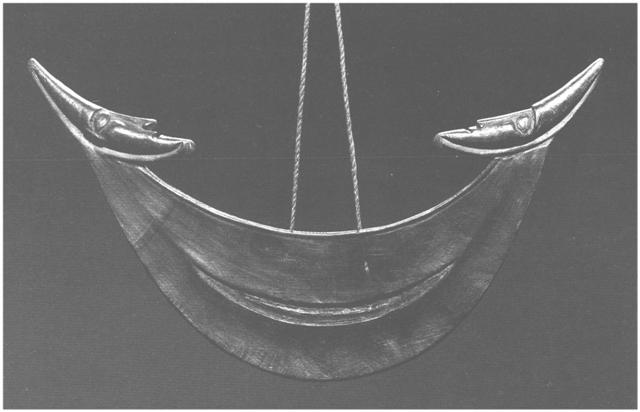Next page:
With 'the Sea' still beginning beyond Nunki in Sagittarius, 'Land' ought to begin (nakshatra wise) at the opposite side of the year, in Gemini. Every night the whole wonderful story was reiterated and at some hour the Milky Way river was level before it began to turn down, before it became like a great canoe with its forward end going down.
We now can guess why the Rei ship always is turned towards the right instead of being level like normal canoes such as the rei miro neck wooden pendants:
Instead of the sun (Cheshire cat) smile in the center between the pair of moon faces in this rei miro the Rei glyphs normally are adorned with moon crescents below their hulls - water (Moon) at the back side means 'water in the past'. In my tables I have gone back in time first with 4 days from the time of rongorongo to the time of Gregorius XIII and then jumped a further 23 precessional days back to the time of Julius Caesar, when Canopus and the right foot of Castor rose in 'May 28 according to my calculations:
I have then made another 14 days precessional jump back in time to when the Hindu station Bharani (Musca Borealis) was close to 0h, and in order to have a clear notational system called these dates e.g. "May 14 (134 = 175 - 4 - 23 - 14).
Assuming 26,000 years for the precessional cycle the time depth to Musca Borealis at 0h was around 41 (= 4 + 23 + 14) / 366 * 26,000 = ca 2900 year counted from 1842 A.D. (which I have used for the time of rongorongo). Around 1060 B.C. the Hindu station Bharani was at 0h. And at that time Canopus and Tejat Posterior rose with the Sun ca 134 ("May 14) - 80 = 54 days later than 0h. And seen close to the right ascension position of the Full Moon in "May 14 was Kaus Australis, a star which rose with the Sun 183 days later, viz. in "November 13 (317) or 54 + 183 = 237 days after 0h. I have assumed 'May 28 (where Canopus and Tejat Posterior were heliacally in Roman times) could be the date 'Vaitu Potu 28 and the month name indicates little (potu) fresh water (vai).
I have not gone back in my presentations as far as to 0h at the feet of Gemini, to Krita Yuga, to the Golden Age when it was easy for the spirits to travel quickly across from autumn equinox to spring equinox avoiding the watery winter:
The Polynesians had their year defined from the Pleiades (Tau-Ono, the 6 stars), anciently the Sign for when the sailing season was beginning: ... Alcyone, daughter of Pleione, 'Queen of Sailing', by the oak-hero Atlas, was the mystical leader of the seven Pleiads. The heliacal rising of the Pleiads in May marked the beginning of the navigational year; their setting marked its end when (as Pliny notices in a passage about the halcyon) a remarkably cold North wind blows ...
The beginning of side a of the G tablet is later than the heliacal rising of Tau-Ono. If we should regard May 16 as day zero, then there will be 8 dark nights before the first glyph on side a (like the length of the dark phase of Venus before her return as morning star):
... We often see the assertion that our title [η Tauri, Alcyone] is in no way connected with Άλκυών, the Halcyon, that 'symbolic or mystical bird, early identified with the Kingfisher', the ornithological Alcedo or Ceryle; so that although the myth of the Halcyon Days, that 'clement and temperate time, the nurse of the beautiful Halcyon', When birds of calm sit brooding on the charmed wave, is not yet understood, some of Thompson's conjectures as to its stellar aspect will be found interesting. He writes that the story originally referred to some astronomical phenomenon, probably in connexion with the Pleiades, of which constellation Alcyone is the principal star. In what appears to have been the most vigorous period of ancient astronomy (not later than 2000 B.C., but continuing long afterwards to influence legend and nomenclature) the sun rose at the vernal equinox, in conjunction with the Pleiad, in the sign Taurus: the Pleiad is in many languages associated with bird-names ... and I am inclined to take the bird on the bull's back in coins of Eretria, Dicaea, and Thurii for the associated constellation of the Pleiad ... Suidas definitely asserts that the Pleiades were called Άλκυόνες. At the winter solstice, in the same ancient epoch, the Pleiad culminated at nightfall in mid-heaven ... This culmination, between three and four months after the heliacal rising of the Pleiad in Autumn, was, I conjecture, symbolized as the nesting of the Halcyon. Owing to the antiquity and corruption of the legend, it is impossible to hazard more than a conjecture; but that the phenomenon was in some form an astronomic one I have no doubt. ... It culminates on the 31st of December. (Allen)
| ||||||||||||||||||||||||||||||||||||||||||||||||||||||||||||||||||||||||||||||||||||||||||||||||||||||||||||||||||||||||||||||||||||||||||||||||||||||||||||














